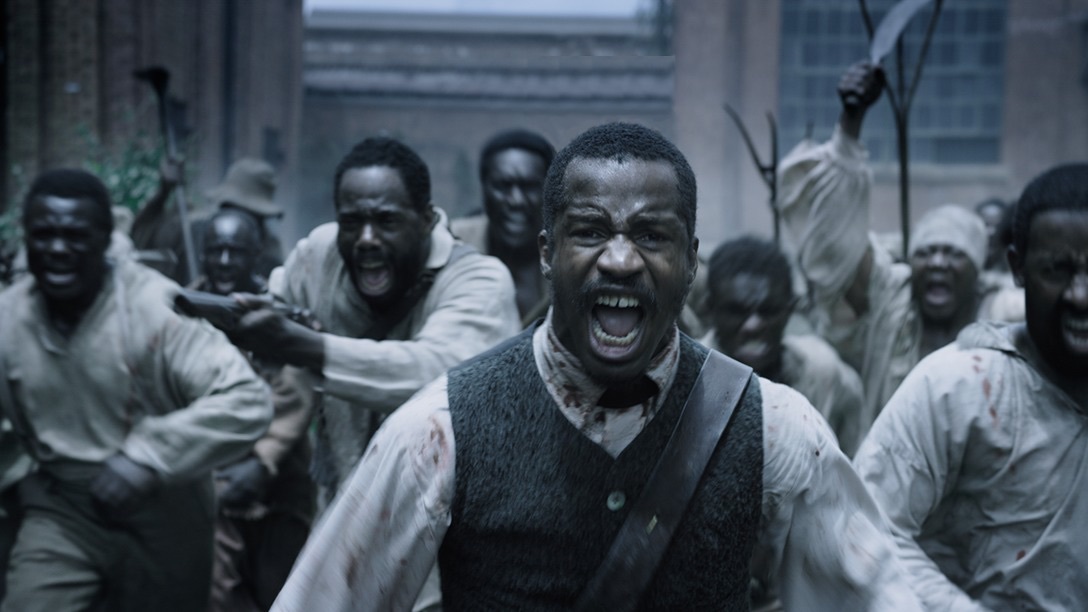Having been both coronated and condemned in the months preceding its release, The Birth of Nation arrives as one of the most complicated pieces of cinema in recent memory. Adored at Sundance and immediately placed atop early Oscar conversations, the film has since been overshadowed by discussions of director, writer, and star Nate Parker’s past. While at Penn State, Parker and a wrestling teammate (Jean McGianni Celestin, the film’s co-writer) were accused of raping a fellow student. Parker was found not guilty, and Celestin’s conviction was overturned, but the murky details of the story and the accuser’s 2012 suicide have left both the film and its star under intense scrutiny.
For now, let us consider the work independent of this controversy. Parker has created a haunting film worthy of much of the praise heaped upon it. Nation, based on the story of Nat Turner’s 1831 slave rebellion, is at times frustrating in its pacing and narrative but nevertheless presents a brutally beautiful portrait of a man and a time, a depiction that will resonate with today’s socially conscious moviegoers. Taught to read as a child slave living on a cotton plantation, Nat is eventually tasked with preaching to fellow slaves at the request of local masters hoping to mollify those longing for rebellion. As Nat travels with his master, Samuel Turner (Armie Hammer), he comes to see the depths of slavery’s brutality, eventually organizing a violent uprising against the community’s white slaveowners.
Personal issues aside (for a moment), Parker’s talent is undeniable. His direction, with the help of cinematographer Elliot Davis, is simultaneously poetic and gruesome; his script feels raw and charged with emotion, and his performance builds and builds until it boils over in the film’s final scenes, though it pales in comparison to the story at large. As Nat’s wife Cherry and master’s butler Isaiah, respectively, Aja Naomi King and Roger Guenveur Smith stand out in limited screen time; they play their characters with subtle beauty, as damaged remnants of once full selves beaten down physically and by the circumstances surrounding them.
Hammer and Jackie Earle Haley—as a sadistic slave-catcher—produce impressive performances, but more notable are the events that wholly overshadow them. Hammer’s Samuel is a weak continuation of his late father’s legacy, often shot in contrast to the vastness of the Virginia cotton fields enclosing him. Haley’s embodiment of evil is just that, a killable vessel for malice, diminutive when compared to the hatred bubbling through the slaveholding Virginia community at large. Some of Parker’s best directing moments come in the form of slow, panning shots over the region’s landscapes, views of cotton fields that extend seemingly farther than the mind can comprehend. This awareness of size and scope diminishes many of the individuals on both sides of the fight but also reminds viewers just how meaningful Nat Turner’s actions were, echoing beyond the edges of endless cotton fields, their legacy enduring long after bullets and bigotry ended the lives of those who prompted them.
While Parker enhances and reimagines certain aspects of historical events, he cannot shy away from the harsh endings met by Nat Turner and his brothers in arms. The rebels killed dozens of whites but were soon stopped, and in the months that followed, hundreds of slaves were murdered and put to death. Turner himself was hanged and his body mutilated. Parker does not deny this ending but instead thrives on it, depicting his lead’s death as a heroic demise. The real-life Turner said, when questioned before being sentenced, “Was not Christ crucified?” Turner dies as thousands of others did, routinely and quickly, but Parker’s telling shows us a man whose death transcends the jeers and vitriol of the white onlookers, whose attitude represented and inspired the feelings of many who came after him, from the Civil War up to the present day.
This is not to say Parker romanticizes the story’s final moments. Far from it. He gives us image after image of bodies hanging from trees, men and women and children, their limp forms drooping with the willows holding them, set against the lushness of the expansive land Parker cannot ignore. On one lifeless body, that of a young boy, sits a vibrant butterfly, beautiful amongst atrocities.
Parker has made his intentions clear, saying “Anyone who sees this film should leave the theater and feel compelled to be a change factor with respect to relations that are taking place in this country.” This message rings out, at times overzealously, throughout the film. Meanwhile, others such as co-star Gabrielle Union and Parker’s accuser’s sister continue to reignite the complexity with which the film will arrive. Perhaps the easiest way to say it is this: if the Penn State events in 1999 had never happened, we would be looking at an undeniably moving film, one that prioritizes society-changing over storytelling but does so with considerable elegance. Unfortunately, the events happened, in one form or another, and Parker will and must face questions regarding them.





